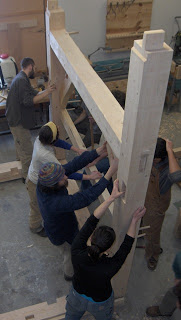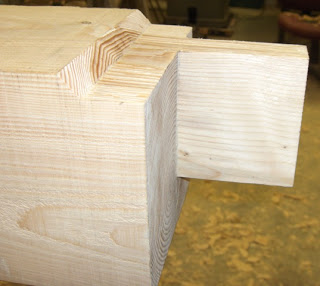 I am so excited about what I learned in my timberframing course that I thought I'd offer a newbie's overview of timberframing for anyone out there who has ever seen a beautiful frame and wondered a little bit about how it's done. I had no idea before I took this amazing class. Even raw beginners can be making tight-fitting (usually too tight) joints in a short amount of time.
I am so excited about what I learned in my timberframing course that I thought I'd offer a newbie's overview of timberframing for anyone out there who has ever seen a beautiful frame and wondered a little bit about how it's done. I had no idea before I took this amazing class. Even raw beginners can be making tight-fitting (usually too tight) joints in a short amount of time.
Timberframing is basically the joining of timbers (cut logs) to form a framework for the creation of a structure like a house, shed or barn. I like to think of it as furniture quality joinery for the purposes of making a beautiful, hearty and safe building.
There are two basic methods of working through laying out and performing the joinery in a timber frame building: scribe rule and square rule. Jack Sobon's works are great resources for learning more about these techniques. Scribing means that timbers are mated by placing them near each other and marking the timbers to follow the natural contours of the each. This means that each timber will only fit well in one particular place in the building and all members must be marked so that the puzzle can be put together properly at raising time.
 We used the "square rule" technique for laying out the joinery for the 8' x 10' garden shed we were building for one of my classmates. The square rule operates on the premise that inside each raw timber is a smaller perfect timber to which we'll mark and cut the joints. This is advantageous because it makes some of the members interchangeable (to a degree). For example, our posts were all approximately 7" x 7" hemlock timbers and we square ruled them down to use the perfect 6.5" x 6.5" timber within wherever there was a joint. To illustrate it further, you can see in the picture how I reduced the top edge of the post I was working on to 6.5" in order to mate with the adjoining timber.
We used the "square rule" technique for laying out the joinery for the 8' x 10' garden shed we were building for one of my classmates. The square rule operates on the premise that inside each raw timber is a smaller perfect timber to which we'll mark and cut the joints. This is advantageous because it makes some of the members interchangeable (to a degree). For example, our posts were all approximately 7" x 7" hemlock timbers and we square ruled them down to use the perfect 6.5" x 6.5" timber within wherever there was a joint. To illustrate it further, you can see in the picture how I reduced the top edge of the post I was working on to 6.5" in order to mate with the adjoining timber.
To use the square rule on a timber, you must first make a thorough inspection of the sides to try to determine which two adjacent sides are closest to being square with each other. Your sawyer should be able to cut the logs well enough for this to be possible on at least two sides. We used framing squares for this as well as for nearly all of our layout tasks. Once you've determined the two squared sides, make black triangles on those sides pointing to their common corner along the timber. These sides of the timber are your reference edges from which all joinery will based.
Our joinery was specifically designed to take advantage of the framing square as it uses many 1.5" and 2" dimensions which match the widths of the two legs of the framing square (as well as the 1.5" and 2" chisels we used). As a side note: If you're using a newer framing square, make sure your legs actually match this dimension instead of taking it for granted. One of my classmates had a brand new square that was slightly bigger than these standard dimensions.
Next time, I'll talk about crucial dimensions and laying out some joints.
